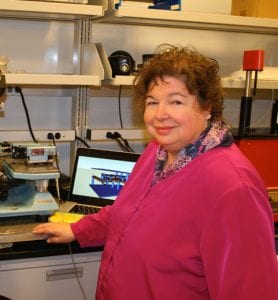Ira Pastor, ideaXme exponential health ambassador and founder of Bioquark, interviews Dr. Alice C. Parker, Dean’s Professor of Electrical and Computer Engineering at the Viterbi School of Engineering, University of Southern California. They talk of Dr Parker’s work to build a synthetic brain.

Ira Pastor comments:
On the last several shows we have spent time talking to many people working on both “the cutting edge” and “the bleeding edge” as it pertains to the various emerging therapeutic and preventative technologies related to health, diseases and the processes of aging.
In doing so we’ve had various guests on who are engineering and building new devices and machines for human enhancement, including bio-artificial hearts, kidneys, bionic prostheses, and exoskeletons.
Building a Synthetic Brain
Today, we are going to go a bit beyond the bleeding edge of things, into what sounds like science fiction and discuss the topic of “Building a Synthetic Brain.”
With a Ph.D. in Electrical Engineering for North Carolina State, Dr. Parker specializes in a diverse range of disciplines including biomimetic neuromorphic circuits, biomimetic stereo vision, retinal and cortical neuromorphic analog circuits, and nanotechnology.
Dr. Alice C. Parker
Dr. Parker has served as the Division Director for Computer Engineering, Dean of Graduate Studies, and Vice Provost for Research at USC.

Extensively published, Dr. Parker’s current research focuses on the Biomimetic Real-time Cortex project based off the National Academy of Engineering’s Grand Challenge, “Reverse Engineering the Brain,” to explore the questions of if, when and how an artificial brain could be constructed for so-called “whole brain emulation,” which includes emulating the complexity of the individual neuronal computations, constructing systems on the scale of the human brain with billions of neurons and trillions of synapses, connecting the neurons for effective and efficient communication, and implementing plasticity, or the ability of the brain to change and grow as learning occurs.
Dr. Parker’s recent work can be viewed here: An Electronic Neuron with Input-Specific Spiking.
On the show we will hear from Dr. Alice C. Parker:
About her background, how she got interested in science, engineering, and this fascinating world of neuromorphic computer design. About the basic approach of the Real-time Cortex Project and the next steps in the research process.

Finally, we’ll gain insight into Dr. Parker’s vision for what these computers could actually be capable of accomplishing in the coming decades and if such computers could exhibit some degree of consciousness.
Credits: Ira Pastor interview video, text, and audio.
Follow Ira Pastor on Twitter: @IraSamuelPastor
If you liked this interview, be sure to check out our interview with Stephen Furber, creator of SpiNNaker!
Follow ideaXme on Twitter: @ideaxm
On Instagram: @ideaxme
On YouTube: ideaxme
Find ideaXme across the internet including on iTunes, SoundCloud, Radio Public, TuneIn Radio, I Heart Radio, Google Podcasts, Spotify and more.
ideaXme is a global podcast, ambassador and mentor programme. Our mission: Move the human story forward!™ ideaXme Ltd.

Pingback: Time Traveler: A Scientist's Mission to Make Time Travel A Reality